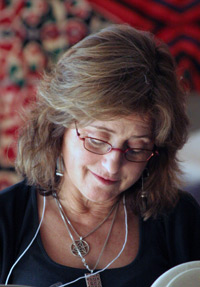Erowid Character Vaults
Allyson Grey
Extended Biography
v1.1 - Nov 10, 2009
Citation: Hanna J. "Erowid Character Vaults: Allyson Grey Extended Biography". Erowid.org. Nov 10, 2009.

Photo by Jon Hanna |
During her twenties, Allyson was secretly bulimic. At a party in 1975, she met the artist Alex Velzy (Grey), whom she later married. Alex and Allyson co-created numerous exhibitions of performance art together in the late 1970s and 1980s, including God's Art (1978), Meditations on Mortality (1980), Wasteland (1982), Fertile Mother (1982), Prayer Wheel (1983), Living Cross (1983), Angel Swing (1984), Soul Furnace (1988), and Goddess (1989). Allyson's only solo piece of performance art was one in which she confessed her secret bulimia, ate, then vomited, while Alex videotaped.
On LSD together in 1976, Allyson and Alex simultaneously shared a psychedelic vision of an infinite omni-directional love energy that comprised the foundational scaffolding of the universe. Experiencing themselves as part of this "oneness of God" caused the illusionary veil of the material world to drop away, inspiring them both to focus on the theme of transcendental spirituality in their art. Allyson completed several pieces of art depicting this shared vision as the subject, using embroidery and painting, sometimes creating mandala shapes by repeating the image of a tiny hand with a pointing finger. Eventually she started working with compositions built from many squares, painting her best-known depiction of their shared vision in 1988: Jewel Net of Indra. (Alex depicted their shared vision in his 1981 painting Universal Mind Lattice.)
Employing a full spectrum of colors, Allyson continued using squares in the construction of her art, "building walls and breaking them down". Built walls represented the "order" of the blissful spiritual world, which Allyson saw as the eternal source of existence. Broken walls represented the "chaos" of the entropic material world, through which all living beings struggle. The balance of order and chaos depicted in Allyson's art eventually became mediated through a third element, her "secret writing". This writing--an alphabet of 20 letters representing the perennial divinity that all religious texts point toward --acts as a window that allows communication between order (spirit) and chaos (matter). As her paintings became more complex, the drawings on which they were based, which mapped out where each color would be painted, could take up to nine months to complete. While many of these works were done in watercolor (including a 24-foot mural commission for the First Bank of Lowell, Massachusetts), Allyson began to also use oil paint on wood panels, to release the pieces from the confines of a framed environment.
Following the birth of the Greys' daughter Zena in 1988, Allyson suffered from post-partum depression, and she dropped the use of color from her work. Using ink wash on paper, she painted a series of numbered Text Pages that incorporated her themes of order, chaos, and secret writing to convey the feeling of looking at an ancient illuminated manuscript published in an unknown sacred script. By the late 1990s, color had returned to her works.
In 1998, Allyson and Alex began working to create the Foundation for the Chapel of Sacred Mirrors, Ltd., a non-profit organization dedicated to the idea that art can assist in the positive transformation of individuals and societies. On September 22, 2004, the Foundation opened the Chapel of Sacred Mirrors (CoSM) as a sanctuary for contemplation in New York City. Numerous paintings by the Greys--including Alex's Sacred Mirrors--were on display at CoSM, and the associated MicroCoSM Gallery held 6-7 exhibits yearly, featuring sacred art from other contemporary artists. By sponsoring regular events and discussion forums, CoSM acted as an East Coast hub for visionary art and culture. At the end of 2008, the CoSM Gallery in New York City closed, as the Foundation purchased land in upstate New York on which to build a larger, permanent facility.
Allyson has bachelor and master's degrees in fine arts from the Boston Museum School. Her work has been exhibited in dozens of galleries and museums throughout the United States. Like her husband Alex, she has spoken worldwide at conferences and gatherings about the positive effect that the judicious use of psychedelics has had on her life and art.

